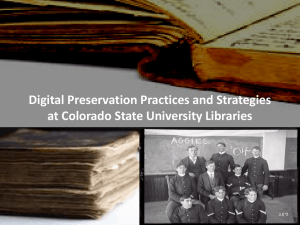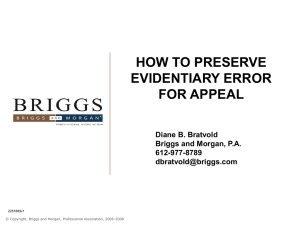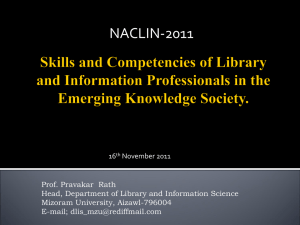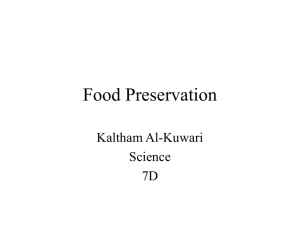See presentation
advertisement
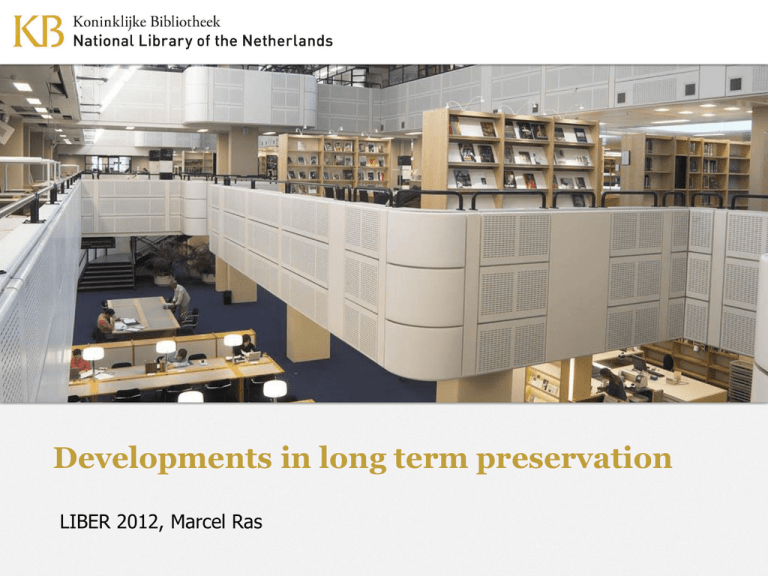
Developments in long term preservation LIBER 2012, Marcel Ras Developments in long term preservation Digital Curation from 2009 to 2012 1. Curating research. 1st LIBER workshop, April 2009 • 2. Focus on organisation issues Curating research. 2nd LIBER workshop, May 2012 • Focus on partnerships “do not go this game alone” Developments in long term preservation Digital Curation KEEP Workshop 26 October 2011 3 Developments in long term preservation Developments in long term preservation Digital Curation - digital preservation Digital Curation refers to the actions people take to maintain, preserve and add value to digital information (assets) over its lifecycle. Digital Preservation refers to the series of managed activities necessary to ensure continued access to digital materials for as long as necessary (processes and procedures required to ensure content remains accessible well into the future). Developments in long term preservation Digital assets • e-books and e-journals • institutional output (theses, education) • digitized collections (books & special collections) • research data • websites • …. Different requirements/roles/partnerships for each category Developments in long term preservation Data growth Developments in long term preservation Digital curation: a role for research libraries? It brings challenges • IT-intensive • requires new and special expertise • financially demanding • requires repositioning the library in the information “chain” The technical challenges are a breeze compared to the organizational challenges Developments in long term preservation Roles and responsibilities in the printed lifecycle producers owners curators users books and journals publishers libraries libraries researchers and students institutional output (theses, etc.) university staff libraries libraries researchers and students special collections various libraries libraries researchers and students curation Developments in long term preservation Roles and responsibilities in the digital lifecycle producers owners custodians users e-journals, ebooks publishers ?? ?? researchers and students institutional ‘output’ (theses, archives) university staff ?? ?? researchers and students digitized books/images libraries themselves libraries themselves libraries themselves researchers and students research data researchers ?? ?? researchers and students websites anyone ?? ?? researchers and students curation Developments in long term preservation Categories of digital resources and risks of data loss technical difficulties organizational difficulties risks that content will be lost e-journals x( xxx) xx xx institutional ‘output’ (theses, archives) xx xx xx digitized books/images x x x research data xxx xxx xxxx websites xxxx xxxx xxxx Developments in long term preservation Parse Insight survey Developments in long term preservation Parse.Insight: Data Managers Developments in long term preservation Parse.Insight: Data Managers Developments in long term preservation Parse.Insight: data managers Developments in long term preservation Parse.Insight: data managers Developments in long term preservation Developments Developments in long term preservation Organisational developments • New roles for Libraries: focus on trio of – Infrastructures – Content – services • • Best practices (or worst) Skill and training in the digital field Developments in long term preservation Skills Developments in long term preservation Cost models • TCP (Total Costs of Preservation) • Involves: systems, services, servers, staff, producers, workflows, content types, storage, monitoring, interventions, management • New Business Models – Business plan KB international e-Depot – Preserving e-journals – About 1,3 million annual costs – Staffing, storage, development, research, preservation actions • But how about preserving research data? And websites? • Shared services Developments in long term preservation Development of cost models – LIFE model – (http://www.life.ac.uk/) – Keeping Research Data Safe – (http://www.beagrie.com/krds.php) – Danish cost model for Digital Preservation (http://www.costmodelfordigitalpreservation.dk/) – DCC&U: an extended digital curation lifecycle model (http://www.ijdc.net/index.php/ijdc/article/view/100) – CDL Cost Modeling for Sustainable Services (https://wiki.ucop.edu/display/Curation/Cost+Modeling) Developments in long term preservation Technical developments • Tool creation becomes mature • Preservation systems available • Shared infrastructures for preserving digital assets • Research and research output to be implemented – PLANETS – SCAPE – KEEP – DRIVER Developments in long term preservation Partnerships Developments in long term preservation Partnerships Between curating organizations With partners in the information chain Public - private information chain Developments in long term preservation Partnering Libraries, Publishers and Archival Solutions Archival Service Archival Agreement Insurance Agreement Preservation Permanent Access Library Publisher Licenses Access Researcher Developments in long term preservation Categories of digital resources and partnership options technical difficulties organizational difficulties partnership options e-journals x(xx) xx (C)LOCKSS, Portico, KB, national deposit libraries institutional ‘output’ (theses, archives) xx xx institutional repositories elsewhere digitized books/images x x other research libraries, national libraries, MetaArchive, national repositories, Hathi Trust (books) research data xxx xxx data archives; discipline-specific research infrastructures websites xxxx xxxx national libraries, Internet Archive, IIPC Developments in long term preservation Developments in long term preservation Being in charge Developments in long term preservation Being in charge • Things you have to do yourself as a research library no matter whom you partner with • Being in charge Deciding what to curate and to what level • Evaluating the results of any partnership • Create policies for curation • Skills and knowledge Developments in long term preservation Preservation policies Preservation Policy: Written statement authorized by the repository management that describes the approach to be taken by the repository for the preservation of objects accessioned into the repository. (APA) • • Describes the intentions of the organization with their digital collections and how to realize these Guidance for the entire organization Developments in long term preservation Benefits of clear policies • Sustainability in managing your digital collections • Change of staff and management less risky • Transfer of knowledge • Education programs (ageing population) • Harmonization of activities • Clear responsibilities • Ideally: Policies are implemented in workflows Developments in long term preservation Readiness for preservation 2009 Planets project survey conclusions: • Awareness in organizations is there • Tools and services are under development • Implementation needed • Improvement compared to survey results 2005 • If a policy was present, preservation was better in shape (more money, plans and awareness) Developments in long term preservation In conclusion • It’s a new ball game with fundamentally new rules • We have to think digitally • We have to create partnerships • And dare to make your choices But we cannot wait until we know everything for certain, because then you will be too late … You’re digital assets are your capital! And again, do not go in this game alone!




